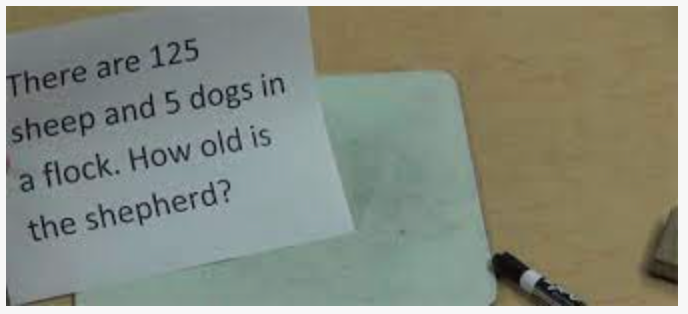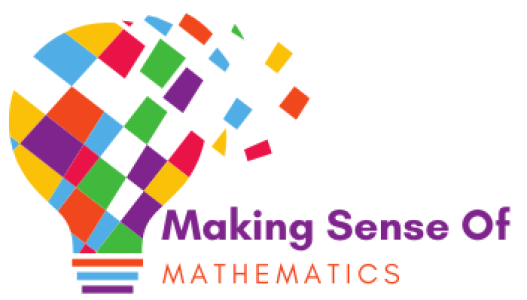In most movies and TV shows with teenage characters, we see them talk about how hard math class is, or how they are failing math. It is also common to hear them say “I’m not good at math” or “I’m not a math person.” Most scenes show the math teacher writing crazy formulas on the board, or students working on a math test and being stressed about it. But when they are showing a Science class, we see the characters working on experiments with a partner or two, talking about it, discussing how to do the experiment.
I keep waiting for this to change, so we can start watching scenes where students are working together during math class, exploring ideas, figuring out how to solve a problem, without fear.
In lower elementary, students that memorize facts are usually considered “math people”; however math facts are a very small part of mathematics and unfortunately students who don’t memorize math facts start to believe that they can never be successful in math. Researchers found that being able to memorize math facts has little to do with having exceptional mathematics potential. (from “Fluency Without Fear”, Jo Boaler, 2015.)
This is why I am writing this blog, to remind us all that if we want students to be math thinkers and problem solvers, and to be successful in math after 5th grade, we need to intentionally provide multiple opportunities for students to develop number sense in the early years.
What is Number Sense?
Before sharing resources and ideas to support your students in developing number sense in your classroom, let’s take a quick look at how some people have defined number sense:
“Thinking flexibly about numbers with purpose and accuracy.”
Andrew Stadel
“Number sense: Plain and simple, number sense is a person’s ability to understand, relate, and connect numbers.”
BY JENNIFER HOGAN, Scholastic
“…a person’s general understanding of number and operations along with the ability to use this understanding in flexible ways to make mathematical judgments and to develop useful strategies for solving complex problems”
(Burton, 1993; Reys, 1991)—from NCTM’s Illuminations website
“All problems could be solved in different ways and we should embrace that. Number flexibility, being able to work with numbers and see what they are made of and combine them in different ways is an important part of number sense.”
Jo Boaler
Resources for the classroom
There are many, many resources out there, but here is a good start:
- FOR PARENTS: If you have the chance to show this video to your students’ parents, it would be very helpful for them to understand why we ask students to explain their ideas and solutions, and why we ask them to solve using different tools/strategies. Robert Kaplinsky’s video shows how students struggle to make sense of math, most students just want to plug in numbers without doing any thinking.

- LESSONS FOR KG-2nd GRADE by Marilyn Burns: Use these incredible lessons to support student discourse, and give them opportunities to reason and share their ideas/solutions. Marilyn Burns is one of today’s most highly respected mathematics educators.
- NUMBER TALKS for lower elementary by Sherry Parish: These resources provide great opportunities for students to make sense of numbers, and use numbers flexibly. Arranging dots that link to previous images can foster connections for students.
- SPLAT MATH by Steve Wybourney: Use these visual representations as number talks in your class. Students will love these, you will see!
- HOW MANY? By Christopher Danielson: In this book there are multiple things to count on each page. Students might count one pair of shoes, or two shoes, or four corners of a shoebox. They might discuss whether two shoes have two shoelaces, or four. They might notice surprising patterns and relationships, and they will want to talk about them.

- 3 ACT TASKS by Graham Fletcher: These tasks provide engaging, thought-provoking contexts for mathematical enquiry. Act 1 shows the context for the enquiry and allows children to generate questions – what do they wonder? What extra information do they need? In act 2, more information is provided; children are then given the chance to speculate and calculate before the solution is revealed in act 3!
- PADLET: You will find a variety of resources for number talks, math tasks, puzzles, challenges and games. Take your time to look at it. It has a lot, but it is all great!
Number sense leads to math fluency
If you want to learn more about number sense, listen to Andrew Stadel’s podcast “A Definition for Number Sense” https://open.spotify.com/episode/2Dqde35paEGJQmi5onLTKD where Andrew provides a working definition for number sense that is concise and memorable. He unpacks the 5 key characteristics from his definition of number sense as a way to guide the learning experiences we provide students and assess student development over time. I highly recomend it!
What about fact fluency? I reread “Developing Numerical Fluency” by Steve Leinwand and Pasty Kanter often, and always learn something new. It provides great strategies to support young learners to not learn by memorization and regurgitation of rules, but to engage students in active thinking and doing, to strategize, reason, justify, and record and report on their thinking.
Last, but not least, to all PreK, KG, and 1st grade teachers: we need you. It is when students are young that they are not afraid of math, it is when they believe they can solve it all. Give them plenty of opportunities to talk about math, and explore, and make sense of numbers. The learning opportunities you provide during these early years will impact how they think of themselves as math students for the rest of their math life. (No pressure!)
Math anxiety has now been recorded in students as young as 5 years old (Ramirez, et al, 2013).
The best way to develop fluency with numbers is to develop number sense and to work with numbers in different ways, not to blindly memorize without number sense.






I’m so excited to have found your site and all of the resources here. Thank you for sharing.
LikeLiked by 1 person
This is exactly what any parent or people who work with children needed. Too many students are afraid of Math. Thanks Caty.
LikeLiked by 1 person
Meaningful and practical blog post! Great resources and ideas! Thanks for sharing!
LikeLiked by 1 person